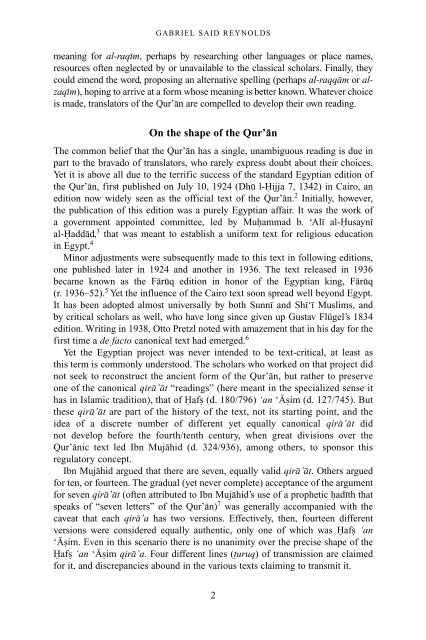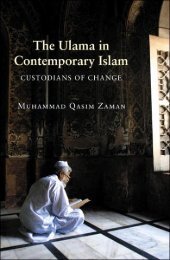The Qur'an in its historical context (pdf - Islam and Christian-Muslim ...
The Qur'an in its historical context (pdf - Islam and Christian-Muslim ...
The Qur'an in its historical context (pdf - Islam and Christian-Muslim ...
You also want an ePaper? Increase the reach of your titles
YUMPU automatically turns print PDFs into web optimized ePapers that Google loves.
GABRIEL SAID REYNOLDS<br />
mean<strong>in</strong>g for al-raqim, perhaps by research<strong>in</strong>g other languages or place names,<br />
resources often neglected by or unavailable to the classical scholars. F<strong>in</strong>ally, they<br />
could emend the word, propos<strong>in</strong>g an alternative spell<strong>in</strong>g (perhaps al-raqqam or alzaqim),<br />
hop<strong>in</strong>g to arrive at a form whose mean<strong>in</strong>g is better known. Whatever choice<br />
is made, translators of the Qur’an are compelled to develop their own read<strong>in</strong>g.<br />
On the shape of the Qur’an<br />
<strong>The</strong> common belief that the Qur’an has a s<strong>in</strong>gle, unambiguous read<strong>in</strong>g is due <strong>in</strong><br />
part to the bravado of translators, who rarely express doubt about their choices.<br />
Yet it is above all due to the terrific success of the st<strong>and</strong>ard Egyptian edition of<br />
the Qur’an, first published on July 10, 1924 (Dhu l-Hijja 7, 1342) <strong>in</strong> Cairo, an<br />
edition now widely seen as the official text of the Qur’an. 2 Initially, however,<br />
the publication of this edition was a purely Egyptian affair. It was the work of<br />
a government appo<strong>in</strong>ted committee, led by Muhammad b. ‘Ali al-Husayni<br />
al-Haddad, 3 that was meant to establish a uniform text for religious education<br />
<strong>in</strong> Egypt. 4<br />
M<strong>in</strong>or adjustments were subsequently made to this text <strong>in</strong> follow<strong>in</strong>g editions,<br />
one published later <strong>in</strong> 1924 <strong>and</strong> another <strong>in</strong> 1936. <strong>The</strong> text released <strong>in</strong> 1936<br />
became known as the Faruq edition <strong>in</strong> honor of the Egyptian k<strong>in</strong>g, Faruq<br />
(r. 1936–52). 5 Yet the <strong>in</strong>fluence of the Cairo text soon spread well beyond Egypt.<br />
It has been adopted almost universally by both Sunni <strong>and</strong> Shi‘i <strong>Muslim</strong>s, <strong>and</strong><br />
by critical scholars as well, who have long s<strong>in</strong>ce given up Gustav Flügel’s 1834<br />
edition. Writ<strong>in</strong>g <strong>in</strong> 1938, Otto Pretzl noted with amazement that <strong>in</strong> his day for the<br />
first time a de facto canonical text had emerged. 6<br />
Yet the Egyptian project was never <strong>in</strong>tended to be text-critical, at least as<br />
this term is commonly understood. <strong>The</strong> scholars who worked on that project did<br />
not seek to reconstruct the ancient form of the Qur’an, but rather to preserve<br />
one of the canonical qira’at “read<strong>in</strong>gs” (here meant <strong>in</strong> the specialized sense it<br />
has <strong>in</strong> <strong>Islam</strong>ic tradition), that of Hafs (d. 180/796) ‘an ‘Asim (d. 127/745). But<br />
these qira’at are part of the history of the text, not <strong>its</strong> start<strong>in</strong>g po<strong>in</strong>t, <strong>and</strong> the<br />
idea of a discrete number of different yet equally canonical qira’at did<br />
not develop before the fourth/tenth century, when great divisions over the<br />
Qur’anic text led Ibn Mujahid (d. 324/936), among others, to sponsor this<br />
regulatory concept.<br />
Ibn Mujahid argued that there are seven, equally valid qira’at. Others argued<br />
for ten, or fourteen. <strong>The</strong> gradual (yet never complete) acceptance of the argument<br />
for seven qira’at (often attributed to Ibn Mujahid’s use of a prophetic hadith that<br />
speaks of “seven letters” of the Qur’an) 7 was generally accompanied with the<br />
caveat that each qira’a has two versions. Effectively, then, fourteen different<br />
versions were considered equally authentic, only one of which was Hafs ‘an<br />
‘Asim. Even <strong>in</strong> this scenario there is no unanimity over the precise shape of the<br />
Hafs ‘an ‘Asim qira’a. Four different l<strong>in</strong>es (turuq) of transmission are claimed<br />
for it, <strong>and</strong> discrepancies abound <strong>in</strong> the various texts claim<strong>in</strong>g to transmit it.<br />
2



